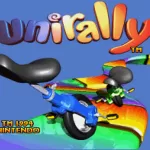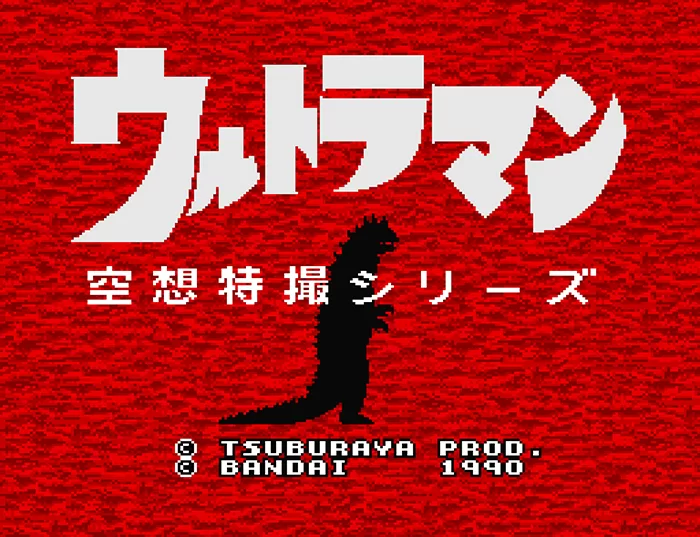
Ultraman for the SNES is… a game. If we stretch that definition about as far as it can go. A good game? No, that’s too far.
In Retro Game Of The Week I pull a game from my collection and write about why it’s important or interesting. Or in some cases, badly dated and rubbish.
Ultraman for the SNES is an odd inclusion in my collection in a number of ways.
Firstly, given my noted passion for all things Godzilla — and by extension, at least something of an interest in most things Kaiju — it’s odd to note that I’ve only actually owned Ultraman for the SNES (or, strictly speaking, the Super Famicom — mine is a Japanese cartridge) for about three months now.
Especially as Godzilla classically made a slightly sneaky appearance in Ultraman… well, sort of. See if you can spot him in this clip:
Yeah, that’s Godzilla… well, two Godzillas actually, because the head is from one movie, the body suit from another and there’s a silly yellow frill. Still, that clip in itself gives you a decent framework to understand what Ultraman is, even though I can curse the fact that Jirass isn’t actually in Ultraman for the SNES.. or the SFC either.
So why didn’t I own Ultraman for the SNES prior to July 2023?
That’s because… well, to cut to the chase, I knew it wasn’t very good.
Legendarily not very good. It was, at the time when the SNES was launching in PAL territories, one of only a handful of games available for the platform.

Ultraman vs Katamari? Nah…. nanananananana, nananananana…
For the longest time I thought it was one of the Japanese launch games, but I was wrong — the SNES launched in Japan on the 21st of November 1990 (yes, that’s 33 years ago next week, try not to think too hard about that, it’ll only make you cry) with just two games — Super Mario World and F-Zero — and Ultraman for the Super Famicom didn’t make his 日本 debut until April the following year.
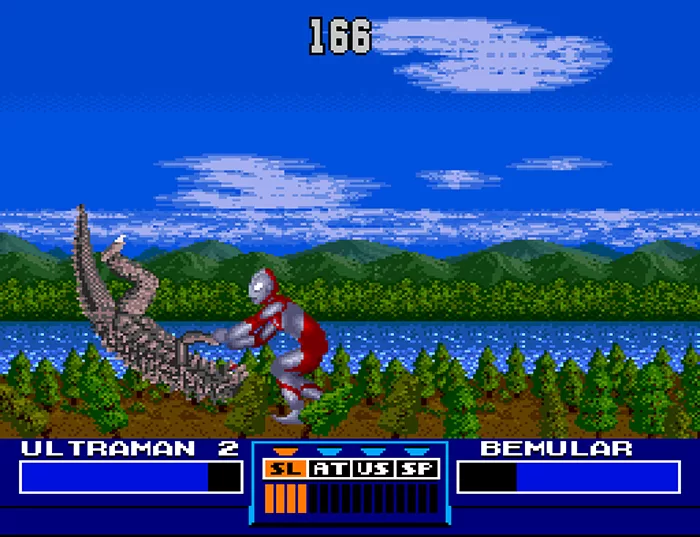
Okada vs Naito, eat your heart out.
Or no, because when this came out, they were only 3 and 8 years old respectively.
It was… not worth the wait. But perhaps I’m getting ahead of myself here, because while Ultraman has seen a fair amount more international exposure since 1990, he’s still not quite a megastar on the level of, say, Godzilla.
In Japan, though, he’s a very big deal, and has been since 1966. One odd difference here between the Japanese and English language versions is that the Japanese version is based on the 1966 series, while the international version is based on the more contemporary (to the time) 1990 series, Ultraman: Towards The Future. They’re mostly the same game engine, but slightly different actual games as a result.
Fun trivia fact: The Towards The Future show was filmed in South Australia, with funding from the South Australian Film Corporation. Was it shown in Australia at the time? No.
My copy is Japanese, based on the 1966 series, which means that I’m playing (technically) as Shin Hayata, capable of turning into the giant alien superhero Ultraman, but only for a limited period of time.
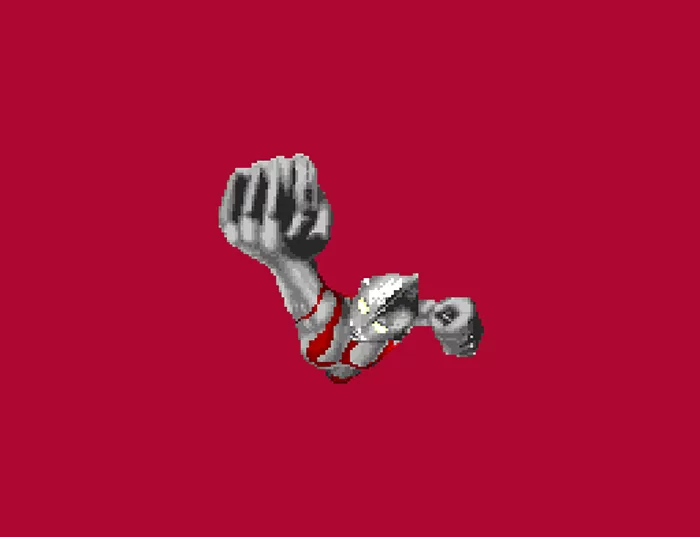
The transformation sequence is quite show accurate — which is to say that it’s a nightmare for anyone with light sensitivity to flashing patterns. Show Ultraman SFC to anyone with epilepsy and you WILL trigger a seizure. Also, it looks like his hands were drawn by AI…
In the game, you’re always working against the timer that ticks down; take too long and you’re no longer a mega-sized hero, just an alien monster’s snack.
Technically if it were the English language version you’d have different monster order, and, looking at a few YouTube playthroughs, a slightly slicker front end as well. But still, it’s the same core game underneath.
Ultraman is a one-on-one fighter, and in the early 1990s, every single fighting game was inevitably compared to Street Fighter II.
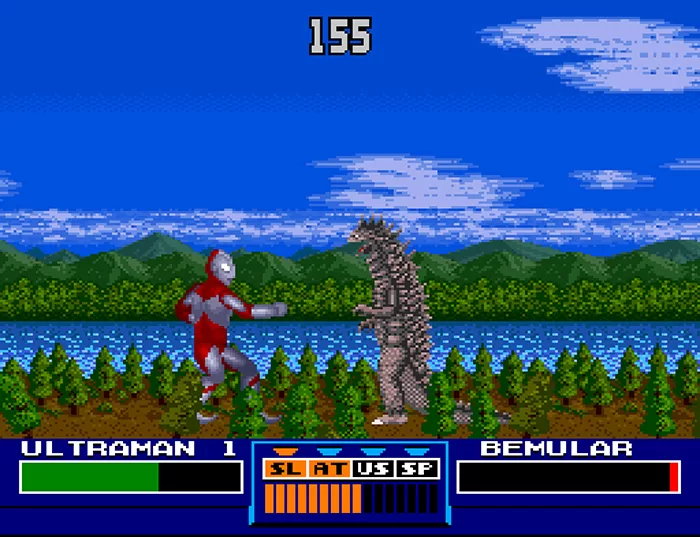
You must defeat my… punch… to stand a chance.
Wait… what? Punch? Not “Dragon Punch” or “Sheng Long” or anything like that?
Nope. Just “Punch”. It’s basically all I’ve got.
That’s a little unfair in Ultraman’s case — it came out before Street Fighter II was actually launched — but it’s still the most obvious comparison, and it’s one that does not favour Ultraman in any way at all.
Frankly, even if we took SF2 out of the equation, the core Ultraman game just isn’t that good.
It’s got some decent enough models that do emulate the look of the 1966 series well enough I suppose, but they animate poorly, and you’re stuck with just one character — Ultraman — to play as.
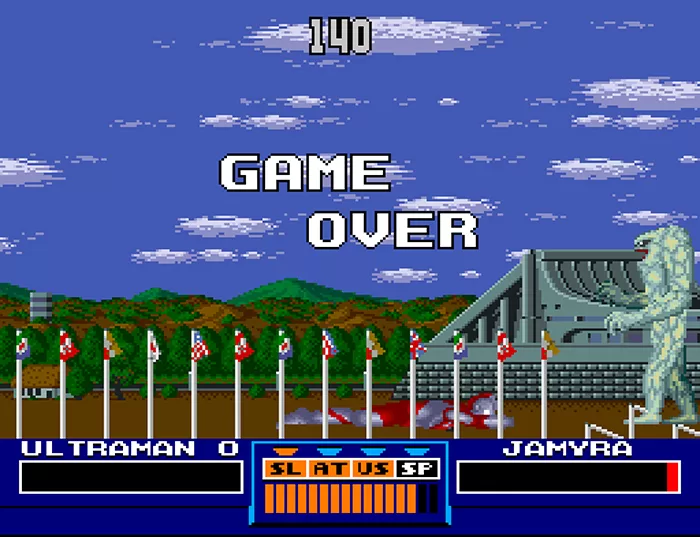
There is one bit of animation that amuses me.
When Ultraman dies — which he will, a LOT — he does a slow Flair flop to the ground.
Sometimes you have to take amusement where you find it.
Ultraman can kick, punch, throw, fire a slowly charging beam weapon… and not much more. The English language release appears to slightly up the move set with a spin kick… but it’s still not much, and it’s all rather slow and ponderous and not that engaging.
Still, you’ll probably persevere on and maybe reduce your Kaiju foe’s health to zero. Battle won, right?

Is Telesdon. Is Good? No. Is No Good.
Nope. You’ll then get a “FINISH” message flashing onscreen, years before Mortal Kombat cornered the market on such things… and not much of an indication of what to do.
What you need to do there is wait for your beam weapon to charge up to its full level, then select that full level with the shoulder buttons and then hit your foe with it.
All the while this is happening, by the way, your should-be-unconscious enemy is still killing you, or at least trying to.

Bemular is sad, because it is not a playable character.
Having a playable roster might have made Ultraman a LOT more enjoyable.
Also, health slowly regenerates in this game, so it’s not all that uncommon to fire your level 4 beam right at the point your foe recovers a tiny sliver of health.
That means you’ll hit them and reduce their energy to the FINISH state… but not actually beat them.
So you wait for your beam to recharge again, all the while trying not to get hit but aware that you do have to hit them to keep their energy low. Eventually you might even do so.

This should feel satisfying. But no.
At which point you realise there’s another 9 of these turgid battles to go.
I have to be honest here — this week, I only got so far into Ultraman, because while I do have a love for Kaiju themes generally, this game is just so utterly dull that I couldn’t bring myself to do much more than play enough to get some varied screenshots. It was dull back in 1990, and time has not been kind to it.
How to play Ultraman (SNES) today
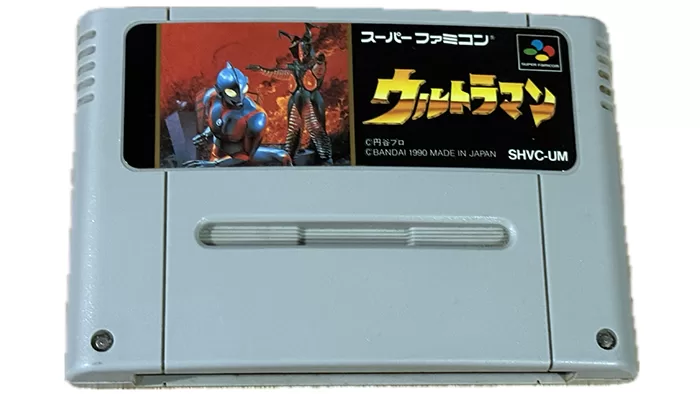
So if I knew it was dull, why did I suddenly pick up a copy this year?
Because I made my way back to Japan for the first time in a few years (you can work out why I might not have visited in the 2020-2022 period if you think hard enough about it) in July this year… and spotted it in a Book-Off for 108 yen including tax. At current exchange rates, that’s $1.10. Yeah, that’s my copy above, in quite clean condition all things considered.
I’ve written previously about how the party of really cheap retro gaming in Japan is all but over, and that’s definitely true for the desirable stuff, and even the more middle ground games, too.
At 108 yen, it’s safe to say that Ultraman isn’t seen as “desirable” by too many retro game collectors.
It was the cheapest thing I picked up retro gaming wise in Japan, and almost the cheapest thing, period.
Honestly, I spent more than this on a drink from a vending machine a few times while I was there. I’ve probably had my $1.10 value out of it since then… but only just.
But maybe you think “Alex, you’re a noted harsh critic! It can’t be that bad! I must check it out for myself!”
Sure, go right ahead. You’ll probably pay a little more than $1.10 for a copy, mind.
I was a little worried researching Ultraman, because sometimes the real stinker games — the ones that were known to be on the nose even back in the day — sold poorly (and deservedly) but are now touted as “rare” as a result. Truly, there are some titles that common stupid money not for their quality as games, but for the quantity one might find.
Seems like Ultraman (SFC) ain’t one of them. I could find copies of Ultraman with asking prices of between $10-$30 loose on eBay, with the English-language release going for a little bit more, typically asking for around $30-$50.
It rather pleases me that actual paid prices sit a little lower than that; around $5-$10 for a Japanese copy and not a lot more for an English language loose copy. Definitely shop around if you really feel like you must own it.
Final trivial factoid: This one of only three (or technically four) games I own for the SNES/SFC that start with the letter “U”… and I’ll probably induct the other proper one as Retro Game Of The Week at some point. Bonus points if you can guess what it is…








